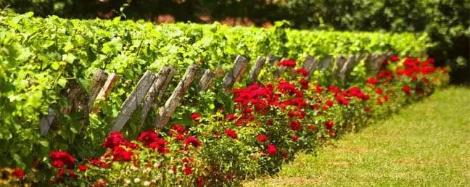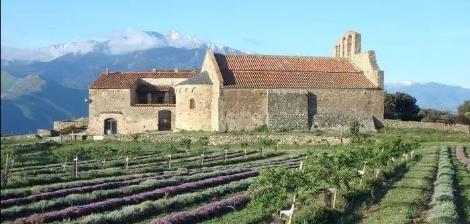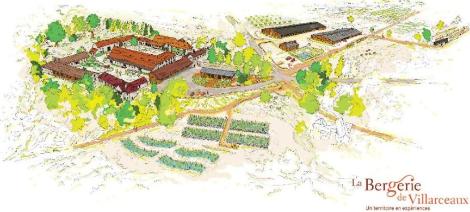PAP 41 : Landscapes for training in agro-ecological transition
The AgroLandscape seminars in Villarceaux and Marcevol
Sophie Bonin, Gaëlle des Déserts, Héloïse Boureau, Dimitri de Boissieu, June 2020
Le Collectif Paysages de l’Après-Pétrole (PAP)
Concerned about ensuring the energy transition and, more generally, the transition of our societies towards sustainable development, 50 planning professionals have come together in an association to promote the central role that landscape approaches can play in spatial planning policies.
Relating experiences, analysing processes, identifying methods, our editorial platform periodically disseminates notes and notes to deepen the debate and facilitate the dissemination of initiatives led by the territories. This month, the Signed PAP is brought to you by Sophie Bonin, lecturer at the Ecole nationale supérieure de paysage de Versailles, and member of PAP.
In order to make a successful ecological transition, agricultural areas offer considerable potential in terms of the living soil areas concerned and the possible improvement of their management for the benefit of biodiversity, food, energy and the living environment. Such a transformation of agricultural systems signifies a profound paradigm shift from the model of industrialisation that prevailed in the 20th century. The massive use of inputs made it possible to neglect the singularity of territories.

Conversely, it is now important to develop a better understanding and consideration of the rural environment and of natural and territorial logics. The restoration of the links between landscape and agriculture has been argued for twenty years by the work of specialists such as Régis Ambroise, François Bonneaud, Véronique Brunet-Vinck, Carine Herbin or Monique Toublanc, and more recently Rémi Janin1. In order to disseminate these skills, it is important to provide common courses where agricultural engineers and landscape architects meet during their training. Exemplary places - presented here - promote this, Villarceaux and Marcevol, where experiments in alternative agricultural systems provide a stimulating framework for original cross-training between agronomists and landscape gardeners2. The need to rebuild a relationship between landscape and agriculture is beginning to emerge and is fairly well publicised in the media3. However, professional cultures remain very different and there are few specialists in dialogue in design agencies and administrations alike. As for the educational offer, for the time being it only concerns a few schools and small numbers of students. It begins as an « off » workshop, by calling for volunteers during school holidays, or as optional experiments within the curriculum. How can we go beyond the occasional interdisciplinary confrontations of a seminar or student work to move towards a general acculturation of these professions and a more systematic methodology in professional practices? Here we will analyse the methodology experimented for several years during the AgroPaysage seminars in Villarceaux, then developed outside the walls in Marcevol in the spring of 2018 in a transdisciplinary spirit. Students from different disciplines are confronted with a complex socio-ecological theme, sensitive to local and field actors: that of the agro-ecological transition of farms, from plot to territory. This situation should enable students to get to know themselves, their concepts and tools better, and to question their formatting in the face of the complexity of the problem. The original pedagogy of this course combines the knowledge and practices of students in landscape and agronomy. The sites that have hosted these seminars have a common history and resonance: in response to modern planning and agricultural thinking, a succession of alternatives have been chosen and experimented with.
Marcevol and Villarceaux, lands of alternative experiments
The agricultural estate of Marcevol, in the commune of Arboussols in the Pyrénées-Orientales, was founded in the 12th century around a monastic settlement. Its buildings and its thirty hectares, perched facing the Canigou, were in a pitiful state when several families, in the 1970s, decided to invest in a collective building site with the collaboration of architects and agronomists. The renovation of the buildings first occupied this group4. With the organisation of courses and discovery classes, this heritage has become a place to stay and cultural activities. The upkeep of a vineyard has persisted, a goat farm and a vegetable garden have been introduced, but the surrounding land fell into decline during the 1980s and 1990s. In order to perpetuate these efforts as a centre of animation and education, a public utility foundation was set up in 20015. A golf course and building complex project near the village had mobilised citizen opposition in the early 2000s, when the agricultural decline was intense. To protect the site around the hamlet (beyond the 500 m perimeter around the historic monument, the church having been listed since 1840), the collective decided to look for development alternatives for the area. The great landscape having become the main issue, the priory undertook to revalorise its land, which had been under threat for two decades, in terms of agro-ecology. In 2016, two hectares will be recultivated around the priory, choosing crops that are economically viable, adapted to a specific environment of poor soils, dry climate and sustained winds, and that enhance the visual quality of the site. To support these three ambitions, specialists from various disciplines are called upon. A prospective approach in a very complex situation is then developed by combining agro-ecological practices (agroforestry, soil conservation, etc.), agricultural diversification, product development, perception of landscape changes and public reception. A system combining aromatic plants, almond trees and vegetable production was selected for their agronomic, ecological and also visual contributions.

For its part, the Villarceaux farm at Chaussy, in the Vexin fançais (Val-d’Oise), fed the seigniorial life of three châteaux between the 13th and 19th centuries. In the 1970s, this 600-hectare estate was to be built to establish a large real estate project around a golf course. The notary’s flight put a stop to this project. The estate was bought by the Charles Léopold Mayer Foundation for the Progress of Humankind in 1976. The land was first cultivated conventionally. In the mid-1990s, the Foundation’s board of directors decided to experiment with the principles of sustainable development and agro-ecology for which it is campaigning. An agricultural transition project was then launched with the contribution of volunteer agronomists and a variety of specialists (zootechnician, arboriculturist, economist). The system of cereal farming on 370 ha was made more complex in order to become more autonomous and resilient, the plots of land were redivided in order to increase the diversity of crops by lengthening the rotation, and paths were created. The complementarity between plant and animal increases the robustness of the system, with the strengthening of the sheep workshop and the creation of a cattle workshop. Around and in the plots, the planting of field trees will regulate the environment (biodiversity, fertility, protection against bad weather, etc.). All of this allows for the recognition of quality (organic farming, Nature and Progress label). The eco-rehabilitation of the old farmhouse, which has become a visitor centre, adopts the means of energy transition (insulation, management of the heating system, solar thermal panels, wood boiler fuelled by locally produced wood chips) and sustainable water management (use of rainwater, phyto-purification, etc.). At the beginning of the project, these transformations were dictated by ecological and agronomic requirements. The idea that they would modify the landscape or could be inspired by it was not thought out as such. Gradually, the development of an agro-landscape project thinking will lead their initiators to aspire to think of the area in terms of landscape, and thus to develop relations with landscape architects. From these experiments carried out in very different agricultural environments - the cereal plateaus of Vexin and the Mediterranean mid-mountains - common features emerge:
-
The history of the places opens up important opportunities for a project: the choice of establishment was based on the landscape value of the site and the beauty of the surrounding landscapes. From this consistency over the centuries between social uses and local resources was born a harmonious composition between man and the land, to quote the title of Eric Dardel’s famous work (1952).
-
The general evolution of agriculture towards globalisation and the industrialisation of practices has led to the abandonment of Marcevol, water pollution and a reduction in biodiversity in Villarceaux. A multi-skilled group decided to experiment with a counter-proposal to restore these areas.
-
To ensure the sustainability of the agroecological and landscaping project, a foundation-type structure carries the initial investments and provides long-term leadership. The two foundations have given themselves a « right to experiment » and intend to transfer the results by example, publications, seminars and training. A sustainable dialogue with local actors (NRP, municipalities, conurbations) promotes the dissemination of the projects devised during the seminars.

These dimensions common to both sites form a system whose power we have been able to test in terms of « training genius ». In Augustin Berque’s dialectic, the landscape is both the imprint and the matrix for ecological agricultural transition projects. These fields, which have been exploited for centuries, are now experimenting with development models that are of interest to students. They will be able to question the transformation of the farming system and bring new ideas, as the pedagogical format allows freedom from norms and constraints.
Cross-learning, cross-fertilisation: the challenges of disciplinary cross-fertilisation
The AgroPaysage seminars are inspired by project pedagogy and are organised over one week. A first immersion sequence allows the students to get to know each other and their respective training courses, and to discover the sites around the agro-ecological theme. This exploration includes visits to farms and the territory, meetings with departments or elected officials to present an exemplary approach or to share their questions on territorial issues. A place is given to field surveys and an active or even reverse pedagogy, which invites participants to express their points of view and questions. The students are divided into mixed groups of five or six and together they write a logbook. The second sequence, « rebound and project », concentrates each group on a more circumscribed site, an operation in a commune: the students work in the classroom or return to the site to draw a desirable or imaginable future for it. The third sequence restores these solutions to the local players. The presentations with posters or models open up discussions with guests and teachers.
The main methodological elements to be acquired during the seminars:
-
The entry by doing, rather than by knowing: as soon as the field is discovered, the question is « what can we do? ». Focused on the development of creativity, the work of the teams focuses on the « desired » and the dreamed. This dimension is introduced as soon as the field is observed through the collective approach and meetings with local actors. Project implementation from the diagnosis phase, what Bernard Lassus called « inventive analysis », is common in the design professions (landscape architect, architect, designer), but unusual for engineers.
-
Graphic representation tools facilitate inter-knowledge and interdisciplinary dialogue; they make the proposals of each group immediately graspable. Schematic representations of the drawing, model or map introduce a sensitive dimension which allows the capture of qualitative data that are difficult to express in terms of objective rationality, because they are either intuitive or artistic. Thus subjectivities are assumed and shared.
-
The repositioning of the problem through changes of scale favours the emergence of new propositions that are otherwise spatialised and contextualised. During the last two AgroPaysage seminars on the energy transition in Villarceaux, the teams were able to move away from focusing on technical objects (the wind turbine, the methaniser, the photo-voltaic panel) and instead explore the relationships to be created between these energy infrastructures and the territory.
-
Reference or calibration figures related to the theme enable the pupils to acquire orders of magnitude that give substance to the proposals. They are essential for defining plausible transition scenarios.
Issues at stake in the agronomy-landscape crossover: some results
Agronomy and landscaping work with the same materials: soil, water, stone, climate, plants. Their role is to guide the development or the care of the land, as they did in the days when the two trades were confused. Today, the values and spirit of these two professions are distinct: one aims for the good, the other for the beautiful; one is useful, the other for the pleasant. The productive is opposed to the contemplative, the modelled objective to the sensible subjective. The scientific and technical specialisation of engineering curricula led to the dissociation of these values throughout the 20th century, as did the evolution of agriculture towards industrialised productivism and a globalised market. At the end of the 20th century, local development and spatial planning issues were minor specialities in agricultural engineering schools. The teaching of landscape drawing did not exist, just as it had almost disappeared from the faculties of geography, even though it remains a beautiful tool for the reading of the territory as well as for the creative and inventive exploration of the project. Reciprocally, training courses on the great landscape and on agriculture only reappeared in landscape teaching at the end of the 20th century. Over and above the need for dialogue between these courses, new issues have been calling for an overhaul of these curricula over the last two decades. The impact of agriculture on the environment has led to a questioning of the productivist model and criticism of the deterritorialisation of agricultural sectors. Other issues concern lifestyles, living and consumption: for a growing number of contemporaries, a new demand has arisen to be able to know where food comes from, and a desire for citizen involvement in the future and the appropriation of one’s living environment. While this remains a priority aim of teaching for agronomists, the management of technical constraints and the development of specialised knowledge capable of ensuring standard production is no longer sufficient when it comes to managing the complexity of problems and the uncertainties of present situations. The advantage of the transdisciplinary approach is that it allows us to go beyond frontiers: from the experience of cooperation, engineers retain above all the importance of « giving to see » among landscape gardeners. Graphic productions provide a common medium accessible to the greatest number, which can be discussed, modified or adjusted. Schematics, cartographies, landscape representations, matrices give back a place to space to elaborate technical solutions adapted to different types of places. Farmers’ jobs and functions can then be seen in a different light. Landscape gardeners use an approach that takes into account the sensory, even emotional, dimension (logbook of itineraries using the five senses, photographs of routes, drawings, landscape representations). They affirm that emotion, action and reflection are linked in the construction of the project in order to know how to feel the space and give it shape. This sensitive approach alone does not produce realistic agro-ecological scenarios. Thanks to the rational and objective contribution of the agronomists, the proposals better integrate the physical, ecological and socio-economic characteristics of the territories. The landscapes of Villarceaux or Marcevol welcome this disciplinary crossroads because they embody and make pedagogically visible this fruitful coexistence between the resolution of problems requiring scientific knowledge and engineering, and the aesthetic apprehension of the environment, an attention to the forms produced, to the emotions, to the enjoyment of each person’s horizons6.

-
1 Cf. the series of publications by collectif APPORT, 2009, as well as the work of Mairie-conseils or the Institut de la vigne et du vin (Carine Herbin); Ambroise R., Bonneaud F., Brunet-Vinck V., 2000, Agriculteurs et Paysages, Educagri-éditions; Toublanc M., 2004. Paysages en herbe, Educagri Editions; Janin R., 2017, La Ville agricole, Editions Openfield. Régis Ambroise, Carine Herbin, Rémi Janin and Monique Toublanc are members of the Collectif PAP.
-
2 The strong interest in building such a cross approach inspired the first AgroPaysage seminar in Villarceaux in 2012: cf. Bonin S., Sanson B., Toublanc M., 2013. L’agriculture, ça regarde les paysagistes… Le paysage, ça regarde les agronomes - Réflexions autour d’une expérience pédagogique pluridisciplinaire entre Vexin et ville nouvelle », in Odile Marcel, Baptiste Sanson (dir.), Paysages de l’après pétrole?, Paris, collection Passerelle n°13, Ritimo/La compagnie du paysage, p. 175-181. Similarly, a symposium of the French Association of Agronomy was held in October 2018, at Le Pradel, Olivier de Serres’ former estate, on the theme « Agronomy and territorial design », with contributions from agronomists, landscape architects and designers. See Revue agronomie environnement & sociétés, vol. 8, n°2, December 2018.
-
3 Cf. for example the Capital Agricole exhibition at the Pavillon de l’Arsenal, Paris, in 2018.
-
4 Marcevol Monastery Association.
-
5 Foundation of the Marcevol Priory.
-
6 Acknowledgements: the AgroPaysage seminars’ pedagogy was built up thanks to the facilitators and project managers of the host structures: Baptiste Sanson, agronomist, who set up these courses in Villarceaux, then Héloïse Boureau and Gaëlle des Déserts, who continued them; and Joaquim Cabrol and Dimitri de Boissieur, who accompanied the Marcevol seminar. Many teacher-researchers have contributed to the adventure: in Villarceaux, Monique Toublanc from the ENSP in Versailles and Marion Diaz from AgroCampus Ouest (Rennes), and since 2016 Marc Benoît, Agnès Fournier and Stéphane Paccaud, from ENSAIA in Nancy, have been leading the students of the Master 2 in Agriculture and Territorial Development. In Marcevol, collaboration with the training of agronomists has been possible thanks to Mélanie Requier Desjardins, from IAMM (Montpellier), who has mobilised the doctoral students of this institute. Finally, we would like to thank Régis Ambroise, godfather of the first seminars in Villarceaux and, on the side of the landscape designers, Baptiste Gallineau and Bertrand Folléa in Villarceaux; Nicolas Antoine and Françoise Crémel in Marcevol.